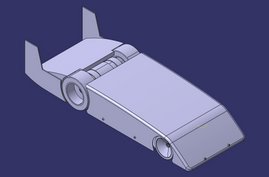Pictures of the X2 progress in chronological order
Sunday, April 22, 2007
Construction Update: Making the body
Friday, April 6, 2007
Locating the CG
 Location of the CG relative to the axles and the ground plane.
Location of the CG relative to the axles and the ground plane. Locating the Center of Gravity is important to help figure out the handling characteristics of the car. CATIA has a very simple way of calculating the CG of an assembly. After all the individual component densities are applied, an overall mass and location of CG can be found. Currently the mass of the car is 2.36 Kg (5.2 lbs).
Subscribe to:
Comments (Atom)




